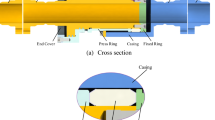Abstract
In this research, the process of electromagnetic tube compression forming was simulated primarily through the sequential-coupled method. The Taguchi method and signal-to-noise analysis were employed to investigate the three effective parameters of the discharge voltage, the thickness of the work piece, and the clearance between the die and the work piece on the depth of bead in this process. The Johnson–Cook damage criterion which usually applies to high strain rate processes was used to predict tearing. The impact of the aforementioned parameters on the Johnson–Cook damage was evaluated by using signal-to-noise analysis. Discharge voltage and the thickness of the work piece, regarding the depth of bead and the Johnson–Cook damage, were significant, while clearance between the die and the work piece had the least influence compared to the other two parameters. Experimental tests were carried out to verify the validation of the results. The simulation results obtained from employing the sequential-coupled method for the depth of bead were 5 % higher than the experimental results. Each objective function of the maximum depth of bead and the Johnson-Cook damage was optimized separately. Finally, the aforementioned two objective functions were optimized at the same time using the method of non-dominated sorting genetic algorithm (NSGA-II). The genetic algorithm method created an optimal and safe area against tearing which is referred to as the Pareto front. This study proposed the amounts of the depth of bead which ranges between 4 and 4.45 mm, with a high safety factor (the extent of Johnson–Cook damage 0.65–0.8).
Similar content being viewed by others
References
Psyk V, Risch D, Kinsey BL (2011) Electromagnetic forming—a review. J Mater Process Technol 211(5):787–829
Cui X, Mo J, Han F (2012) 3D multi-physics field simulation of electromagnetic tube forming. Int J Adv Manuf Technol 59(1):521–529
Daehen GS, B.S. A, Balanethiram M, Fenton VS, Padmanabhan BS, Tech B, M., Tamhane A (1995) High-velocity metal forming—an old technology addresses new problems. JOM 47(7):42–45
Jblonski J, Wnkler R (1978) Analysis of the electromagnetic forming process. Int J Mech Sci 20(5):315–325
Takatsu N, Kato M, Sato K, Tobe T (1988) High speed forming of metal sheets by electromagnetic forces. JSME Int J 31(1):142–148
Murakoshi Y, Takahashi M, Sano T, Hanada K, Negishi H (1998) Inside bead forming of aluminum tube by electro-magnetic forming. J Mater Process Technol 80–81(1):695–699
Imbert JM, Winkler SL, Worsxick MJ, Oliveira DA, Golovashchenko S (2005) The effect of tool–sheet interaction on damage evolution in electromagnetic forming of aluminum alloy sheet. J Eng Mater Technol 127(1):145–153
Thomas JD, Seth M, Daehn GS, Bradley JR, Triantafyllidis N (2007) Forming limits for electromagnetically expanded aluminum alloy tubes: theory and experiment. Acta Mater 55(8):2863–2873
Correia JPM, Siddiqui MA, Ahzi S, Belouettar S, Davies R (2008) A simple model to simulate electromagnetic sheet free bulging process. Int J Mech Sci 50(1):1466–1475
Ebrahimi H, Fallahi AR, Farzin M, Attaran M, Tavangar M (2010) Numerical and experimental investigation of inward tube forming by electromagnetic forming. Adv Mater Res 383–390:6710–6716
Bartels G, Schätzing W, Scheibe HP, Leone M (2009) Comparison of two different simulation algorithms for the electromagnetic tube compression. Int J Mater Form 2(1):693–696
Hiping YU, Chunfeng LI, Jianghua DENG (2009) Sequential coupling simulation for electromagnetic–mechanical tube compression by finite element analysis. J Mater Process Technol 209(2):707–713
Mohammadi nia M (2012) Couple simulation of tube electro-magnetic inward forming. Amirkabir University of Technology
Johnson GR, Cook WH (1983) A constitutive model and data for metals subjected to large strains, high strain rates and high temperature. Paper presented at the In Proc. 7th International Symposium on Ballistics
Corbett BM (2006) Numerical simulations of target hole diameters for hypervelocity impacts into elevated and room temperature bumpers. Int J Impact Eng 33(1):431–440
Teng X, Wierzbicki T (2006) Evaluation of six fracture models in high velocity perforation. Eng Fract Mech 73(12):1653–1678
Wierzbicki T, Bao Y, Lee YW, Bai Y (2005) Calibration and evaluation of seven fracture models. Int J Mech Sci 47(4–5):719–743
Wang X, Shi J (2013) Validation of Johnson-Cook plasticity and damage model using impact experiment. Int J Impact Eng 60:67–75
Roy RK (2010) A primer on the Taguchi method, 1st edn. Society of Manufacturing Engineers
Kalyanmoy D (2001) Multi-objective optimization using evolutionary algorithms. Wiley
Wei L, Yuying Y (2008) Multi-objective optimization of sheet metal forming process using Pareto-based genetic algorithm. J Mater Process Technol 208(1):499–506
Wei L, Yuying Y, Zhongwen X, Lihong Z (2009) Springback control of sheet metal forming based on the response-surface method and multi-objective genetic algorithm. Mater Sci Eng A 499(1–2):325–328
Author information
Authors and Affiliations
Corresponding author
Rights and permissions
About this article
Cite this article
Shabanpour, M., Fallahi Arezoodar, A. Multi-objective optimization of the depth of bead and tearing in electromagnetic tube compression forming. Int J Adv Manuf Technol 87, 867–875 (2016). https://doi.org/10.1007/s00170-016-8519-2
Received:
Accepted:
Published:
Issue Date:
DOI: https://doi.org/10.1007/s00170-016-8519-2



